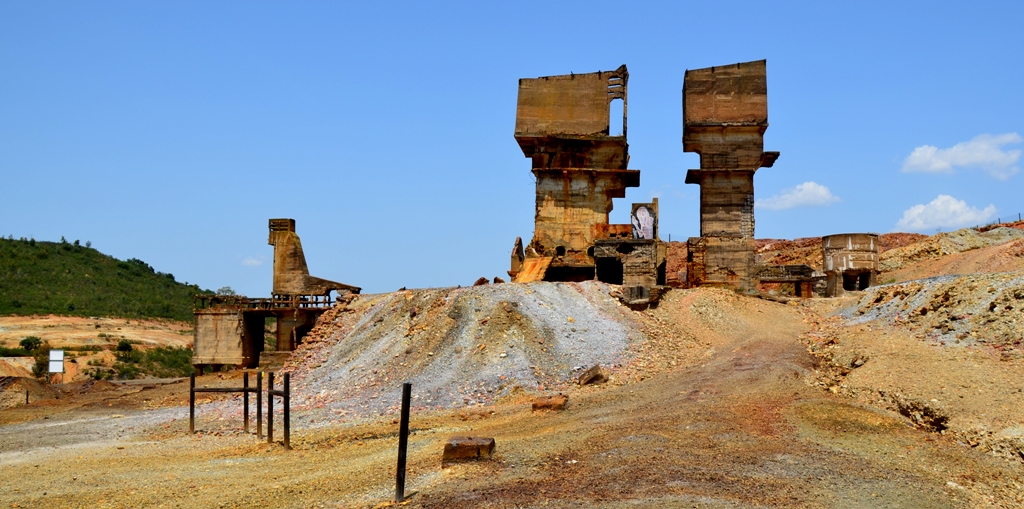Open Pit Mining, Mina de São Domingos
The open pit mining of the Sao Domingos Mine is the result of the open pit mining exploitation that begun in 1867. It has a depth of 120m and a perimeter of approximately 2 km. The materials that were extracted from this location, largely comprised of pyrite oxidation and lixiviation (the "gossan" from the English "gold sand") were gradually organised into excavation heaps around the open pit and the mining village, definitively transforming the topography and the surrounding soil. In 1890, the open pit was concluded and all of the sterile materials, or those which were not immediately useful (the "gossan" did not at that time represent any possibility for profitable industrial usage, although it did contain gold and silver in not negligible porportions) were found distributed among the various "tipes" (English term for excavation heap "tip" was adopted by the mining population and continues through the present). During the 19th century these were known as the tip of Vinha, the tip of Hospital and the tip of 12 Meters. The open pit mining required the removal of the majority of the buildings which were built over the iron deposit of the Serra of Sao Domingos at that time, crossed various Roman galleries, which permits current visitors to obtain a direct perception of the depth reached by the ancient works and the size of the galleries in which the Roman miners worked. Additionally it provides for the appreciation of the extraordinary lithic variety present in the location. After the conclusion of the laboratory in 1966, the abandonment of the extraction of water from the bottom of the mine resulted in a rise of the level of the water table within the open pit to the present-day level, which appears to be stationary. The water contained in the open pit today is extremely acidic (pH=2) and contains, in solution, a large amount of sulphates, especially iron and arsenic sulphates, but also copper and zinc.
CHARACTERISTICS
City: Mina de São Domingos
Postal Code: 7750 - 146
Telephone: 286647534
Email: fserraomartins@gmail.com
Website: http://fundacaoserraomartins.pt/
Specific Conditions:
In the event of an individual or group of smaller size want to make the visit, the price charged will be equivalent to that paid by a group with 6 persons.
Method:
On foot
Difficulty Level:
Average
Group Visits:
Yes
Minimum Number of Person per group:
6
Maximum Number of Person per group:
25
Observations:
Exceptionally, visits may be made with a greater number of participants.
Guided Tours:
Yes
Observations:
Old Mining Complex - Guided tours of the Mina de S. Domingos and former industrial complex A urban circuit in the village of Mina de S. Domingos and a route that evokes the ore cycle in times of great Mine laboring. An open air museum that marks the experiences and the various stages of harvesting and processing the ore.
Mining facilities in a gallery
Táxi
Agency Name:
Geral Táxis
Telephone Number:
286611117
Type of Transport:
T. Rodoviário
Agency Name:
Rodoviária do Alentejo
Telephone Number:
284313620
Parking for private vehicles:
Yes
The Pyrite Route is a thematic route of mining and geological tourism dedicated to the Iberian Pyrite Belt, considered one of the main mining regions of Europe, with more than 90 known massive sulphide deposits, distributed throughout the regions of Alentejo and Andalusia. In addition to the pyrite mines occur in the province hundreds of manganese deposits and veins of copper, lead, barium and antimony.











